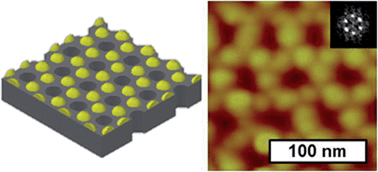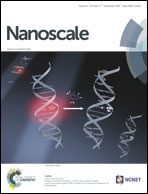Self-ordering of small-diameter metal nanoparticles by dewetting on hexagonal mesh templates†
Abstract
Arrays of small-diameter nanoparticles with high spatial order are useful for chemical and biological sensors, data storage, synthesis of nanowires and nanotubes, and many other applications. We show that self-ordered metal nanoparticle arrays can be formed by dewetting of thin films on hexagonal mesh substrates made of anodic aluminum oxide (AAO). Upon heating, the metal (Fe) film dewets onto the interstitial sites (i.e., the node points) between pores on the top surface of the AAO. We investigated the particle morphology and dynamics of dewetting using a combination of atomic force microscopy (AFM), grazing-incidence small-angle X-ray scattering (GISAXS), and numerical simulations. Templated metal particles are more monodisperse and have higher local order than those formed by the same dewetting process on flat, nonporous alumina. The degree of order depends on the initial film thickness, and for the optimal thickness tested (nominally 2 nm), we achieved uniform coverage and high order of the particles, comparable to that of the AAO template itself. Computational modeling of dewetting on templates with various pore order and size shows that the order of AAO pores is primarily influential in determining particle position and spacing, while the variance in pore size is less impactful. Potential uses of these ordered nanoparticle arrays on porous materials include plasmonic sensors and spatially controlled catalysts.


 Please wait while we load your content...
Please wait while we load your content...